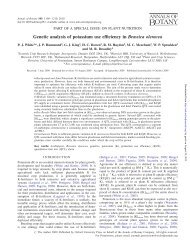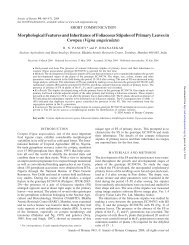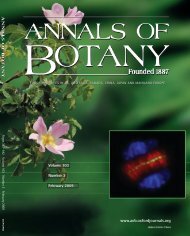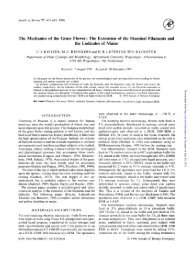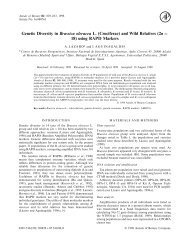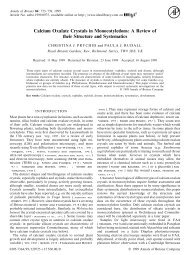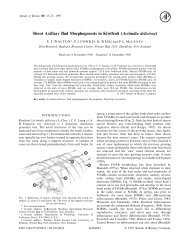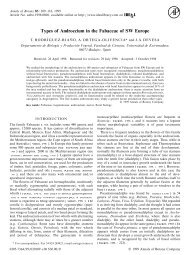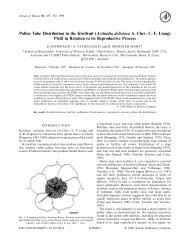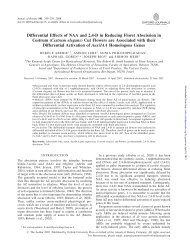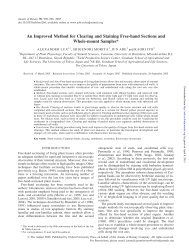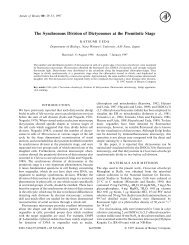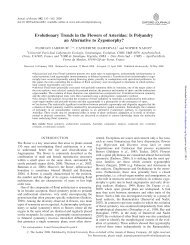Floral Structure of Kirkia (Kirkiaceae) and its ... - Annals of Botany
Floral Structure of Kirkia (Kirkiaceae) and its ... - Annals of Botany
Floral Structure of Kirkia (Kirkiaceae) and its ... - Annals of Botany
Create successful ePaper yourself
Turn your PDF publications into a flip-book with our unique Google optimized e-Paper software.
540<br />
100<br />
51<br />
Outgroups<br />
100<br />
Biebersteiniaceae<br />
100<br />
Nitrariaceae<br />
100<br />
Sapindaceae<br />
87<br />
94<br />
<strong>Kirkia</strong>ceae<br />
69<br />
100<br />
Anacardiaceae<br />
100<br />
Burseraceae<br />
100<br />
51<br />
100<br />
Rutaceae<br />
100<br />
Simaroubaceae<br />
100<br />
Meliaceae<br />
F IG. 1. Phylogenetic relationships in Sapindales, based on rbcL<br />
sequences (Bayesian posterior probabilities indicated above the branches;<br />
simplified from Muellner et al., 2007).<br />
Botanical Garden, Pretoria (South Africa), to E. Ramp in<br />
1987. The material was studied using light microscopy<br />
(LM) <strong>and</strong> scanning electron microscopy (SEM). For LM<br />
investigations, the material was embedded in Kulzer’s<br />
Technovit 7100 (2-hydroxyethyl methacrylate), following a<br />
protocol adapted from Igersheim (1993) <strong>and</strong> Igersheim <strong>and</strong><br />
Cichocki (1996). Serial microtome sections were made at<br />
5, 7 or 10 mm, using a Microm HM 355 rotary microtome<br />
<strong>and</strong> a st<strong>and</strong>ard microtome knife D. The sections were<br />
stained with ruthenium red <strong>and</strong> toluidine blue, <strong>and</strong><br />
mounted in Histomount (protocol adapted from Weber <strong>and</strong><br />
Igersheim, 1994). For SEM investigations, specimens were<br />
stained with 2 % osmium tetroxide, dehydrated in ethanol<br />
<strong>and</strong> acetone, critical-point dried <strong>and</strong> sputter coated with<br />
gold, <strong>and</strong> studied at 20 kV with a Hitachi S-4000 scanning<br />
electron microscope. The fixed material <strong>and</strong> permanent<br />
slides <strong>of</strong> serial microtome sections are deposited at the<br />
Institute <strong>of</strong> Systematic <strong>Botany</strong>, University <strong>of</strong> Zürich (Z).<br />
A B<br />
Bachelier <strong>and</strong> Endress — Flowers <strong>of</strong> <strong>Kirkia</strong> <strong>and</strong> Position in Sapindales<br />
C<br />
Morphology<br />
RESULTS<br />
The flowers are arranged in compound thyrsoids with the<br />
cymes dichasial <strong>and</strong> in higher branching orders monochasial.<br />
Although functionally unisexual, the flowers are<br />
always morphologically bisexual. They are polysymmetric<br />
<strong>and</strong> isomerous, <strong>and</strong> mostly tetramerous (Figs 2 <strong>and</strong> 3).<br />
Pentamerous or hexamerous flowers are also found on<br />
some low branching orders, <strong>and</strong> trimerous flowers on high<br />
branching orders.<br />
The flowers are relatively small (,1 cm in diameter).<br />
They have long, jointed pedicels <strong>and</strong> a broad floral base.<br />
They are haplostemonous, with the stamens alternipetalous<br />
<strong>and</strong> the carpels antepetalous (Figs 3 <strong>and</strong> 4A). A short floral<br />
cup is formed by congenitally united petal <strong>and</strong> stamen<br />
bases (Fig. 3C, G, H).<br />
Sepals are free <strong>and</strong> triangular (Fig. 2A–C). They are contiguous<br />
(valvate) in early stages <strong>of</strong> development but later<br />
the floral base <strong>and</strong> floral cup enlarge <strong>and</strong> thus their aestivation<br />
becomes open (Fig. 2A–D). The base <strong>of</strong> the sepals<br />
takes part in the floral cup but their extended margins<br />
remain free <strong>and</strong> overlap basally (Figs 2D <strong>and</strong> 3C, G, H).<br />
In tetramerous flowers, the sepals are arranged in pairs<br />
with the outer pair in median position (Figs 2A–C <strong>and</strong> 3).<br />
In pentamerous flowers, their aestivation is quincuncial at<br />
the base.<br />
Petals are free, linear <strong>and</strong> acute (Fig. 2A, F). Basally,<br />
they exp<strong>and</strong> between the sepal margins with a dorsal<br />
bulge (Fig. 4A). In contrast to the sepals, their aestivation<br />
is basally open but it is imbricate further up (Fig. 2A, E)<br />
<strong>and</strong> two patterns are observed in tetramerous flowers: (1)<br />
one petal inside, one petal outside, <strong>and</strong> two in between<br />
(Fig. 3A, B), or (2) two petals outside <strong>and</strong> two inside<br />
(Fig. 3E, F). The petals protect the inner floral organs in<br />
D<br />
F<br />
E G<br />
F IG.2. <strong>Kirkia</strong> wilmsii. Flower buds <strong>and</strong> parts <strong>of</strong> flower buds. (A) Bud, lateral view, arrowhead points to close-up in (D). (B) Same bud, from above, with<br />
sepals arranged in decussate pairs. (C) Another bud, from below, with sepals arranged in decussate pairs. (D) Bud shown in (A), lateral view, close-up on<br />
floral base <strong>and</strong> overlapping sepal margins (arrowhead). (E) Petal aestivation basally open <strong>and</strong> imbricate further up. (F) Petal tip, dorsal side. (G) Carpet <strong>of</strong><br />
secretory hairs on inner side <strong>of</strong> petal base. Scale bars: A, C ¼ 400 mm; B ¼ 200 mm; D, E, F, G ¼ 100 mm.




